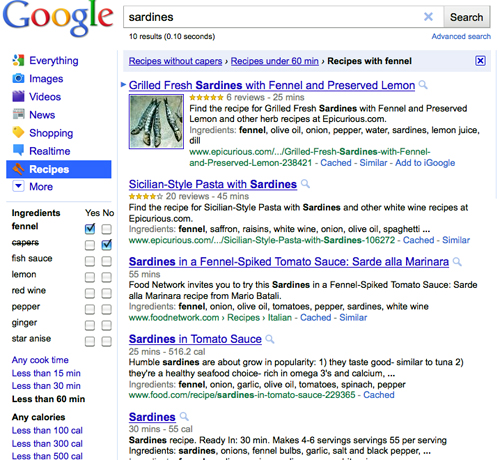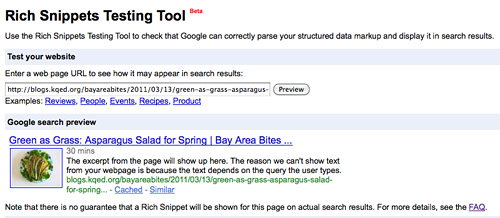Google is out to tame the Wild West of the food world, and I'm not really sure how I feel about this. A couple of weeks ago, Google introduced Recipe View, a search function Bing had added last year. Initially, I loved the idea that people would be able to search for recipes exclusively and that Google had taken the time to create a recipe search tool specifically for cooks, but then I saw the search results and my hopes deflated. I was disappointed to see that although larger recipe food sites are well represented, nary a blog post was listed for the many searches I initiated. Allrecipes.com, Food.com, the Food Network, About.com and Epicurious made up the majority of search results, while blogs -- both well-known and obscure -- seemed not to have been invited to the party (yet).
The whole point of Google's new recipe search is to allow people to designate what they're looking for in a recipe, which in turn limits the search to recipes only. So if you're looking for information on "sardines" you will end up with just recipes instead of a Wikipedia entry plus a bunch of shopping results. Google Recipes also allows you to limit your search by ingredients (do you want to cook your sardines with fennel and without capers, just check the boxes on the left side of the page), cook time (less than 60 min.), and calorie count (any calories). Helpful and fantastic, right? Yes, but recipe blog posts that might rank high in Google's Everything search due to popularity are not likely to be there. Not yet.

Sardines search using Google Recipe View
Why I am disappointed
It appears that Google has chosen to given preference to large company recipe sites over smaller sites, newspapers, magazine, and blogs. According to The Stew, a food blog put out by the Chicago Tribune who interviewed Jack Menzel, Google's product management director for this project, "About a year ago, Google began asking food sites if they would add a snippet of code to their HTML pages which contained time and servings info." But it seems they primarily asked the larger sites, like FoodNetwork.com, to partner with them in this endeavor. The Stew then goes on to say:
"It's going to favor some of the biggest sites and those who have optimized their content to be found easily by search engines. Expect a lot of FoodNetwork.com and AllRecipes.com recipes to pop up on the first page of any search."
So, how do blogs get included? In order for a site's recipes to be indexed by Google's new recipe search they have to meet some specific and not-so-specific criteria.
